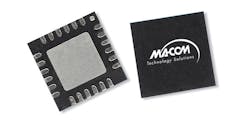Switches are invaluable components for routing and controlling high-frequency signals in different types of systems. For applications as wide as DC to 20 GHz and in miniature surface-mount packages, Richardson RFPD is now offering an extensive line of high-frequency switches from MACOM Technology Solutions with excellent electrical characteristics. Available in single-pole, single-throw (SPST); single-pole, double-throw (SPDT); double-pole; double-throw; and other switch configurations, the switches are suitable for a variety of uses—from defense to commercial applications.
The compact RF/microwave switches (see figure) are based on a reliable 0.5-μm GaAs pseudomorphic-high-electron-mobility-transistor (pHEMT) semiconductor process. They achieve insertion loss as low as 0.5 dB and are capable of handling as much as 10 W input power. As an example, model MASW-007107 is a SPDT switch for use from DC to 8 GHz. It exhibits 0.5 dB insertion loss from 2 to 6 GHz, with just 0.75 dB insertion loss from 6 to 8 GHz. It has 16 dB return loss from DC to 8 GHz. The typical isolation between ports is 29 dB at 2.4 GHz, 33 dB at 5.3 GHz, 30 dB at 5.8 GHz, and 20 dB typical isolation from 6 to 8 GHz.
The switch boasts an input third-order-intercept point (IP3) of typically +57 dBm at 2.4 GHz and typically +54 dBm at 5.8 GHz. It handles as much as +32 dBm input power with a +3-VDC control and as much as +34 dBm input power with a +5-VDC control. The switch, which has 35-ns typical turn-on and turn-off time, is supplied in a 2 {MULT} 2 mm, 8-lead PDFN package
For broader-bandwidth applications, model MASW-008322 is a SPDT switch that operates from DC to 20 GHz. It suffers only 1-dB insertion loss at 10 GHz and 1.9-dB insertion loss at 20 GHz, and provides 48-dB isolation at 10 GHz and 40-dB isolation at 20 GHz. The VSWR is a low 2.0:1 from 1 to 20 GHz. It has an input P1-dB point of +30 dBm from 0.5 to 20.0 GHz and is designed for operating temperatures from -40 to +85°C. The switch has an input IP3 of +48 dBm from 0.5 to 20 GHz and can handle input signal levels to +33 dBm with a -8.5-VDC control. It features a 9-ns rise/fall time and is supplied in a 4 x 4 mm, 24-lead PQFN package.
For those in need of lower frequencies and a somewhat smaller package, model MASW-010612 is a single-pole, three-throw (SP3T) switch for use from DC to 3.5 GHz. The RoHS-compliant switch is supplied in a 1.5 x 1.5 mm, eight-lead, PDFN package. Designed for low-voltage, low-loss applications, this switch works with a 1.8-V supply and suffers only 0.6-dB typical insertion loss across its full frequency range. It handles better than +34 dBm power at 1-dB compression and has a typical input IP3 of +54 dBm. The typical isolation between ports is 21 dB while the typical return loss is 20 dB. The typical turn-on and turn-off times are better than 30 ns, for high-speed applications.
These switches are available in a variety of different frequency ranges and switch configurations. The GaAs pHEMT process is fully passivated to preserve performance and ensure reliability. The switches are available in stock and from immediate delivery from Richardson RFPD.
Richardson RFPD, 40W267 Keslinger Rd., P.O. Box 307, LaFox, IL 60147-0307.
